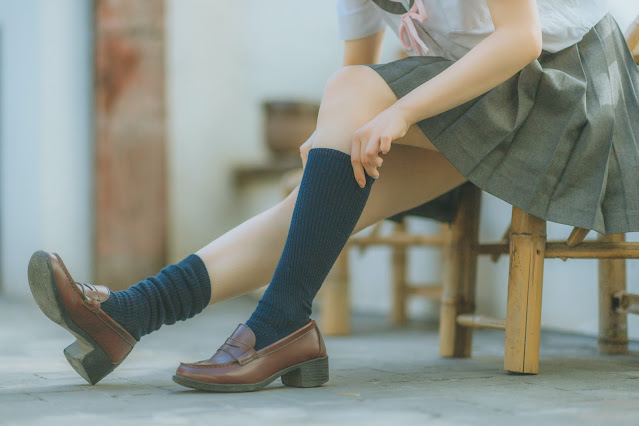Photo by Nishikino Maki on Unsplash
What is your first thought when someone mentions compression socks? Do you imagine uncomfortable hosiery in dull beige colors only the elderly wear? While that might have been the case decades ago, the variety and quality of compression socks have improved dramatically. Nowadays, function and fashion go hand in hand.
Compression socks provide relief and comfort to all ages – whatever your walk of life, chances are that compression socks can make your steps lighter. Their primary role was to help people dealing with blood circulation problems in their lower extremities. Naturally, it wasn’t long before the benefits of compression socks became widely known – now they’re used by millions of people who spend most of their time on the move.
How do compression socks work?
The first compression socks showed up in the 1930s, even though compression therapy had its place in medicine long before that. They were first developed to help alleviate problematic venous conditions like varicose veins, deep vein thrombosis (DVT), and spider veins.
Modern socks use graduated compression to provide gentle pressure to the lower leg, allowing easier blood flow from the ankles to the knee and all the way to the heart. Designed to be comfortable, as well as helpful, these socks prevent swelling, discomfort, pain, and blood clots.
With time, compression socks found a wide variety of uses and are now the go-to garment of doctors, nurses, athletes, pregnant women, and travelers. As the demand grew, so did the necessity to make the socks more aesthetically pleasing.
The results have been incredible, and today, compression socks are not only a therapeutic aid but also a fashion statement. Quality brands, such as VIM&VIGR's compression socks, put a lot of effort and time into making sure their product is up to standards, both on the function and fashion front. There’s an array of both colorful patterns and classic monochromatic options on offer, so it’s easy to find just about any design you can think of.
Who can use compression socks?
The sky's the limit, really. Compression socks are first and foremost made for people struggling with different venous conditions, but their role has significantly evolved over time.
Professionals who spend a lot of time on their feet wear compression socks to avoid uncomfortable swelling and overwhelming tiredness after a day’s work.
You’ve probably seen players of your favorite sports wear compression socks. Athletes use them to up their performance and diminish the chance of injury.
These garments, especially compression tights, are very popular with pregnant women. They can be a saving grace for the swelling and leg pain that usually comes with pregnancy.
Regular travelers who spend a lot of time on airplanes often use “flight compression socks.” Changes in pressure during flights can cause swelling and aches in lower extremities, and in some more extreme cases, blood clotting. Planning a vacation can be challenging enough, you don’t want to show up with achy feet and swollen ankles. Compression socks help you feel more comfortable and diminish health risks.
For optimal effect, remember to take off your socks before you go to bed, so that your legs can breathe and relax.
Compression Socks as a Fashion Choice
One of the best qualities of human creativity is that we can turn anything and everything into a fashion statement. That’s exactly what happened with compression socks – an item that was first and foremost made to be functional is now worn like a fashion choice and a therapeutical aid.
Modern-day compression socks tick all the boxes – they sport beautiful, eye-catching patterns and are comfortable. To make sure they fit you just right, pay extra attention when choosing the right compression level, size, and material.
Compression Levels
Simply put, compression levels show the strength and support of compression socks. The level of pressure is expressed through mmHg (millimeters of mercury) – the higher mmHg, the stronger the support.
If you plan on using them every day to feel good and improve circulation, you want compression socks in the 8–20 mmHg range.
Maybe you need more support because you’re dealing with DVT, varicose veins, and lymphatic edema. In that case, use socks with moderate compression levels, 20–30 mmHg.
For people who are facing acute pain and swelling from DVT or blood clots, a doctor can prescribe firm compression, which can range from 30–50 mmHg.
Best Materials
When it comes to choosing the fabric for your compression socks, you should take into account your personal preferences, skin sensitivity, and compression levels.
Cotton compression socks are the go-to option because they’re the most comfortable and the compression will feel more natural. Cotton is also light and lets your skin breathe.
Nylon compression socks and their variations are perfect for people who work out and train regularly. They’re not as soft as the cotton ones, but the fabric is smooth and light, and some have moisture-wicking properties.
Wool is often the material people swear by when it comes to compression socks. It combines the best qualities of cotton and nylon, with the added advantage of temperature regulation. This makes them a superb fit for every season and type of activity.
High-quality materials used in compression socks add to the sense of style as well. When you use premium fabrics and garments that fit you well, you can’t help but feel better in your own skin.
Modern Compression Socks – Function and Fashion Combined!
Modern compression socks prove you that don’t have to forego your sense of style for health anymore. You want your socks to be of good quality, to fit you well, and fulfill their purpose, whether it’s helping your circulation, boosting your physical performance, reducing swelling, or letting you travel in comfort. Of course, your well-being comes first, but now you can zhuzh things up with fashionable choices, feel great, and look even better.
